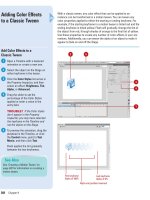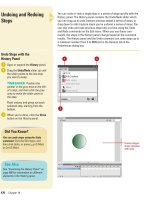Tài liệu Thiết kế flash với flash cs5 part 82 pdf
Bạn đang xem bản rút gọn của tài liệu. Xem và tải ngay bản đầy đủ của tài liệu tại đây (882.34 KB, 7 trang )
ptg
498
Chapter 20
When you work with a profile, you're creating a time-saving file that
lets you use the same settings over and over again. Not only does Flash
make the creation of a profile easy; it will let you create a duplicate of
the file. In truth, a duplicate file would not serve much of a purpose:
Why would you want an exact copy of something that already exists?
Actually, creating a duplicate can be a very smart thing to do. For
example, say you create a profile for a specific job that involved sev-
eral changes to the default settings, and you name it: Output_A. Then,
two weeks later you need another profile that's almost exactly the
same as Output_A, with one or two minor changes. Rather than start
from scratch, you create a duplicate of Output_A, make the minor
changes, and Export it using the name: Output_B. It's fast and easy,
and it means you're working smart.
Duplicating a Profile
Duplicate a Profile
Click the File menu, and then click
Publish Settings.
Click the Current Profile list arrow,
and then select the profile you
want to duplicate.
Click the Duplicate Profile button.
Give the duplicate a new name.
Click OK.
5
4
3
2
1
2
3
4
See Also
See “Exporting and Importing a
Profile“ on page 496 for more informa-
tion on how to export a Flash
publishing profile.
5
From the Library of Wow! eBook
ptg
Chapter 20 Publishing a Movie
499
Previewing a Flash movie is an important part of the design process. As
you work, you should periodically stop and preview the movie. It's also
a good idea to periodically save your document. In fact, you should
always save the Flash document before previewing. That way, if there
happen to be any problems, it's an easy matter of restoring the file from
the last-saved version. To preview your Flash SWF file with the publish-
ing format and settings you've selected, you can use the Publish
Preview command. This command exports the file and opens the pre-
view within the default browser.
Previewing a Movie
Preview a Movie
Click the File menu, point to
Publish Preview, and then select
from the following options:
◆
Default (HTML). Select this
option to display the Flash
document within an HTML
document.
◆
Flash. Select this option to
create and play a Flash .swf
file.
◆
HTML. Same as Default
(HTML).
◆
GIF. Select this option to create
a GIF version of the currently
selected frame in the Timeline.
◆
JPEG. Select this option to
create a JPEG version of the
currently selected frame in the
Timeline.
◆
PNG. Select this option to
create a PNG version of the
currently selected frame in the
Timeline.
◆
Projector. Select this option to
display the Flash document in a
self-contained projector file.
1
1
Changing Magnification in Flash Player
In the Flash Player, you can increase or decrease the magnification
of the current Flash movie (SWF), as well as play, rewind, step for-
ward, or step back. To zoom in or out in a browser, press
Control+click (Mac) or right-click (Win) anywhere in the movie win-
dow, and then click Zoom In or Zoom Out. Click Show All to see the
entire Flash movie.
For Your Information
From the Library of Wow! eBook
ptg
500
Chapter 20
As you work, you should periodically stop and test your movie as a
Flash SWF. The Test command allows you to quickly see your movie on
different devices and players—Flash Professional, Device Central
(
New!
) or Air Debug Launcher (Desktop or Mobile) (
New!
)—without
leaving the program. The Test command tests the movie based on the
current test option. Flash uses the document type the default until you
change it. Each time you test your movie as an SWF, Flash creates a log
entry in the SWF History in the Property Inspector (
New!
). The SWF
History shows you the difference in file size between the different tests.
If there is over a 50% increase in size, a warning icon appears next to
the log entry. In the SWF History, you can view or clear the log entries.
Testing a Movie
Test a Movie and View a
SWF History
Click the Control menu, and then
point to Test Movie.
Select the option where you want
to test your movie:
◆
in Flash Professional. Plays the
movie in a separate window in
Flash Professional.
◆
in Device Central. Opens
Adobe Device Central CS5 and
displays the movie.
◆
in Air Debug Launcher
(Desktop). Opens Adobe Air
Player for the desktop and
displays the movie.
◆
in Air Debug Launcher
(Mobile). Opens Adobe Air
Player for mobile devices and
displays the movie.
◆
Test. Performs a test with the
currently selected test option.
TIMESAVER
Press Ctrl+Enter
(Win) or
A
+Return (Mac).
To view and work with the SWF
History log, click the Window
menu, and then click Properties to
open the Property Inspector.
◆
Clear the SWF History. Click
the Clear button.
◆
View the SWF History Log.
Click the Log button.
3
2
1
1
2
3
From the Library of Wow! eBook
ptg
Chapter 20 Publishing a Movie
501
To view the performance of a Flash document using a graph, use the
Bandwidth Profiler. The Bandwidth Profiler displays how much data is
sent for each frame in the active Flash document, according to the
speed you specify. The Bandwidth Profiler has two windows. The left
window shows information about the active document and the current
download settings, and the right window displays information about
each frame in the document. In addition, the Bandwidth Profiler lets
you view how the page loads, based on a specific bandwidth. For
example, you could specify to load the Flash document using a speed
of 28.8Kbps. To maintain an accurate download test, the Bandwidth
Profiler compensates for added compression support applied to SWF
files, which reduces the file size and improves streaming performance.
Using the Bandwidth
Profiler
Use the Bandwidth Profiler
Click the Control menu, point to
Test Movie, and then click Test.
Click the View menu, and then
click Bandwidth Profiler.
Click the View menu, point to
Download Settings, and then
select from the available
bandwidth options, or click
Customize, and then create a user-
defined setting.
Click the View menu, and then
click Simulate Download.
This tests the load of the Flash
movie against the current settings.
4
3
2
1
Test movie
bandwidth
settings.
Timing Rule
A timing rule used in Web design is called the 10-second rule. If doc-
uments load too slowly, there's a good chance that your visitors will
not wait for the document to load, and will move on to other pages.
The Bandwidth profiler gives you a real taste of what your visitors
are going to experience when they download your Flash movies.
For Your Information
From the Library of Wow! eBook
ptg
502
Chapter 20
Flash can export an entire movie or frame to several different formats
that are not included in the Publish Settings dialog box. These formats
include Adobe FXG, Bitmap, JPEG Image or Sequence, GIF Image or
Sequence, PNG Image or Sequence, Quick Time (MOV), Animated GIF,
Windows AVI, and WAV (for Windows only). When you export a movie
or image (frame), some file formats require you to select additional for-
mat specific options, such as resolution (dots per inch) and number of
colors or color bit depth, to complete the operation. To set the resolu-
tion to match your monitor, select Match Screen.
Exporting a Movie to
Different Formats
Export a Movie Frame to
Different Formats
Open a document.
Select a frame you want to export
in the Timeline.
Click the File menu, point to
Export, and then click Export
Image.
Navigate to the location where
you want to save the file.
Enter a name in the Save As (Mac)
or File Name (Win) box.
Click the Format popup (Mac) or
the Save As Type list arrow (Win),
and then select a file format.
Click Save.
Some file formats require you to
select additional format specific
options to complete the operation.
If a dialog box appears, select the
options you want, and then
click OK.
8
7
6
5
4
3
2
1
Available file formats
5
4
7
6
Options vary
depending on
export format
8
From the Library of Wow! eBook









